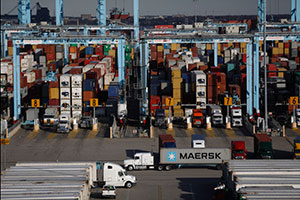Managing Editor, Features and Multimedia
Port of Virginia Sets Volume Record for July

The Port of Virginia said it handled 226,000 TEUs in July, an increase of 9% from a year earlier, with truck volume rising 6% and rail volume increasing 15%.
TEUs, total containers and total rail containers were the highest for the month of July in the port’s history, said John Reinhart, CEO and executive director of the Virginia Port Authority.
“At our terminals, we are beginning to process the volumes associated with the coming retail season, and we anticipate this trend continuing through November,” he said.
Reinhart said the port also is working to upgrade its facilities and investing in personnel and technology to improve service and add capacity.
“Last year’s peak season presented several significant challenges, and we learned a lot in that period,” he said. “From that experience, we are in stronger position to strategically act to handle volume and build velocity with consistent service.”
The Port of Virginia expects TEUs and rail and truck volumes to continue to grow, Reinhart added.
However, the Panama Canal Authority’s plans to temporarily restrict the depth of vessels using the canal could result in a “meaningful shift of freight back to the West Coast,” at least for a while, said analyst Christian Wetherbee of Citibank.
“It’s likely that containerships en route to East Coast ports from Asia will be more greatly impacted given their average size near the canal’s maximum depth,” he said in an Aug. 11 note.
The canal authority is setting the restrictions, which go into effect Sept. 8, due to lower water levels caused by drought.
On the West Coast, container trade at the Port of Long Beach, California, climbed 18% last month to 690,244 20-foot equivalent units, the port’s preliminary estimates showed.
However, the neighboring Port of Los Angeles said July cargo volume declined 2.5% from a year ago, to 699,127 TEUs.
The Port of Oakland, California, reported higher activity in July, with volumes edging up 1% to 205,521 TEUs.
Robert Salmon, a Deutsche Bank analyst, said total imports at the three California ports rose 5.7% in July on a year-over-year basis, reversing a 4% decline in June.
“We were pleasantly surprised by the [California] import strength given recent reports of elevated inventories at some retailers,” he said in an Aug. 17 note to investors, adding that the uptick bodes well for back-to-school freight volumes.
Salmon described the growth of California imports as a “positive data point” for truckers, given its correlation with for-hire truck tonnage on a one-month lagging basis.
Port of Long Beach said loaded inbound volume increased 16% to 345,912 units last month, while loaded outbound units also climbed 16%, to 143,875 units. Empty units jumped 24% to 200,457.
For its fiscal year to date, the Port of Long Beach said it has handled 5.73 million TEUs since Oct. 1, which is 2% ahead of the previous year’s pace.
Imports at the Port of Los Angeles fell 3.5% to 350,627 TEUs, and exports dropped 16% to 136,402 last month, but empty container movements increased 11%.
The nation’s largest container port said it handled 4.6 million TEUs during the first seven months of 2015, down 3.5% from the same period in 2014.
The Port of Oakland said loaded container imports rose 9% to 79,713 TEUs, while loaded exports edged up 1% to 74,913. Its year-to-date volumes declined 6% to 1.29 million TEUs.

